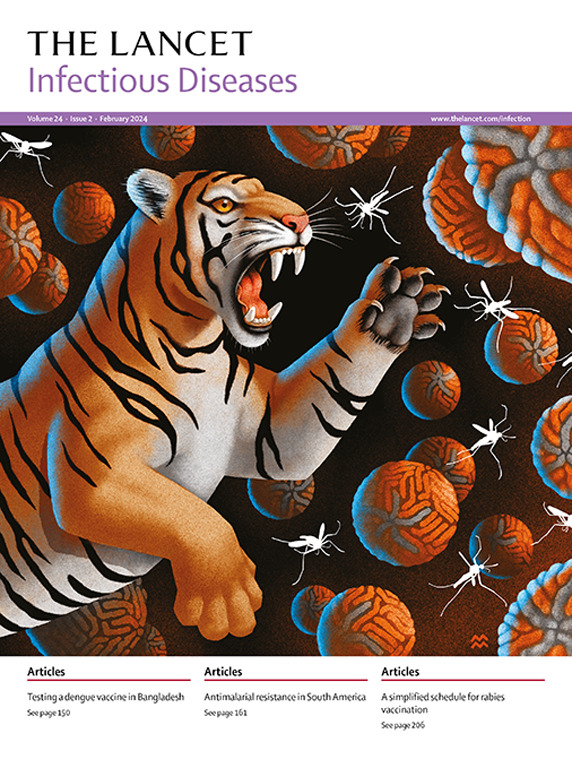Immunogenicity, safety, and efficacy of the vaccine H56:IC31 in reducing the rate of tuberculosis disease recurrence in HIV-negative adults successfully treated for drug-susceptible pulmonary tuberculosis: a double-blind, randomised, placebo-controlled, phase 2b trial
IF 36.4
1区 医学
Q1 INFECTIOUS DISEASES
引用次数: 0
Abstract
Background
People with tuberculosis who complete treatment remain at risk of recurrent disease. The vaccine H56:IC31 has been shown to be safe and immunogenic in phase 1 and 2 studies, but whether it can reduce the risk of tuberculosis recurrence is unknown.Methods
In a double-blind, randomised, placebo-controlled, phase 2b trial in South Africa (five clinical trial sites) and Tanzania (one clinical trial site), we enrolled participants aged 18–60 years, without HIV, who had completed more than 5 months (22 weeks) of treatment for drug-susceptible pulmonary tuberculosis. During trial screening (≤7 days after starting treatment), two sputum samples were obtained and frozen for later comparison to recurrent isolates by whole-genome sequencing (WGS). Eligible participants were randomly assigned (1:1; block size of four) to receive two intramuscular doses in the deltoid, 56 days apart, of H56:IC31 or placebo. After the first dose of H56:IC31 or placebo, participants were followed up until study day 421 (1 year after the second dose) and checked at each visit for tuberculosis signs and symptoms. If tuberculosis was suspected, two sputum samples were obtained: one sample was tested by automated molecular test (Xpert MTB/RIF Ultra) and sent for liquid culture; and the other sample was stored frozen for later analysis by whole-genome sequencing (WGS). At the last visit (day 421), two sputum samples were obtained from all sputum-productive participants, regardless of symptoms, to detect cases of asymptomatic tuberculosis. The primary endpoint was culture-confirmed recurrent pulmonary tuberculosis (due to relapse with the same strain, reinfection by a different strain, or indeterminate) occuring during the period starting at day 70 (14 days after the second dose) and ending on day 421 (1 year after the second dose). Vaccine efficacy against recurrent tuberculosis was derived from Cox proportional hazards models. Secondary endpoints included vaccine efficacy to prevent tuberculosis relapse or reinfection independently, as differentiated by WGS, and safety and immunogenicity outcomes (H56-specific CD4 T-cell responses and humoral anti-H56 IgG responses). Primary analysis of vaccine efficacy was based on modified intention-to-treat (mITT), in all randomly assigned participants except those with tuberculosis disease recurrence or who withdrew before day 70 (or 14 days after the second dose for those who received both doses). Safety was assessed in all randomly assigned participants who received at least one dose of vaccine or placebo. The trial was registered with ClinicalTrials.gov, NCT03512249, and is complete.Findings
831 participants (mean age 34·7 years [SD 11·1]; 229 [28%] female and 602 [72%] male; 549 [66%] Black) were enrolled from Jan 31, 2019, to Jan 20, 2022; 415 participants were randomly assigned to receive H56:IC31 and 416 to receive placebo. Follow-up was completed by March 20, 2023 (mean follow-up duration 410·1 days [SD 82·8]). In the primary mITT analysis, recurrent tuberculosis occurred in 23 of 400 participants in the H56:IC31 group (12 relapses, eight reinfections, and three indeterminate); and in 14 of 406 in the placebo group (six relapses, seven reinfections, and one indeterminate). Vaccine efficacy for prevention of recurrence was –73·8% (95% CI –246·9 to 9·8; p=0·10). Vaccine efficacy for prevention of relapse was –116·1% (–522·2 to 16·3; p=0·11) and for prevention of reinfection was –21·1% (–245·3 to 56·5; p=0·71). 2 weeks after the planned second dose, H56:IC31 had significantly increased the frequencies of H56-specific CD4 T cells expressing interferon-γ, tumour necrosis factor, interleukin (IL)-2, or IL-17 in vaccinees (median percentage of CD4 T cells, 0·35% [IQR 0·19 to 0·57]) compared with placebo (0·11% [0·09 to 0·23]; p<0·0001). H56-specific IgG responses were significantly higher in H56:IC31 recipients (median arbitrary units per mL, 6·84 [IQR 1·64 to 32·8]) than in placebo recipients (1·94 [1·05 to 3·86]; p<0·0001). A greater proportion of H56:IC31 recipients had mild-to-moderate injection site reactions than placebo recipients (165 [40%] of 415 vs 78 [19%] of 416). No treatment-related serious adverse events were reported. Two participants who received H56:IC31 and six who received placebo died.Interpretation
Vaccination with H56:IC31 at treatment completion for pulmonary tuberculosis did not reduce the risk of recurrent disease. H56:IC31 was well tolerated and immunogenic but might have increased the risk of relapses by endogenous strains.Funding
The European and Developing Countries Clinical Trials Partnership (EDCTP2) supported by the EU (grant number RIA2016V-1631, POR TB consortium). Additional funding to support completion of the trial was provided by the Statens Serum Institut, Aurum Institute, and the South African Tuberculosis Vaccine Initiative.疫苗H56:IC31在成功治疗药物敏感肺结核的hiv阴性成人中降低结核病复发率的免疫原性、安全性和有效性:一项双盲、随机、安慰剂对照的2b期试验
背景:完成治疗的结核病患者仍有疾病复发的风险。在1期和2期研究中,H56:IC31疫苗已被证明是安全和免疫原性的,但它是否能降低结核病复发的风险尚不清楚。方法:在南非(5个临床试验点)和坦桑尼亚(1个临床试验点)进行的一项双盲、随机、安慰剂对照的2b期试验中,我们招募了年龄在18-60岁、未感染艾滋病毒、已完成5个月(22周)以上药物敏感肺结核治疗的参与者。在试验筛选期间(开始治疗后≤7天),采集2份痰液样本并冷冻,以便后期通过全基因组测序(WGS)与复发性分离株进行比较。符合条件的参与者随机分配(1:1;块大小为4)在三角肌接受两次肌内注射剂量,间隔56天,H56:IC31或安慰剂。在第一剂H56:IC31或安慰剂后,参与者被随访至研究第421天(第二次剂量后1年),并在每次就诊时检查结核病体征和症状。如怀疑为肺结核,则取两份痰液样本:一份样本经自动分子检测(Xpert MTB/RIF Ultra)检测后送液体培养;另一份样品冷冻保存,以备全基因组测序(WGS)分析。在最后一次访问(第421天)时,从所有产生痰的参与者(无论症状如何)采集了两份痰样本,以发现无症状结核病病例。主要终点是在第70天(第二次剂量后14天)至第421天(第二次剂量后1年)期间发生的培养证实的复发性肺结核(由于同一菌株复发,不同菌株再感染或不确定)。疫苗对复发性结核病的有效性由Cox比例风险模型得出。次要终点包括疫苗预防结核病复发或再感染的有效性(由WGS区分),以及安全性和免疫原性结果(h56特异性CD4 t细胞应答和体液抗h56 IgG应答)。疫苗有效性的主要分析是基于改进的意向治疗(mITT),在所有随机分配的参与者中,除了结核病复发或在第70天之前退出的参与者(或在第二次剂量后14天接受两次剂量的参与者)。对所有随机分配的接受至少一剂疫苗或安慰剂的参与者进行安全性评估。该试验已在ClinicalTrials.gov注册,编号NCT03512249,目前已完成。研究结果:831名参与者(平均年龄34.7岁[SD 11.1];女性229人(28%),男性602人(72%);2019年1月31日至2022年1月20日,共入组549人(66%);415名参与者随机分配接受H56:IC31治疗,416名接受安慰剂治疗。随访于2023年3月20日完成(平均随访时间410·1天[SD 82·8])。在最初的mITT分析中,H56:IC31组400名参与者中有23人复发结核(12人复发,8人再感染,3人不确定);406名安慰剂组中的14名(6名复发,7名再感染,1名不确定)。疫苗预防复发的有效率为- 73.8% (95% CI为-246·9 ~ 9.8;p = 0·10)。疫苗预防复发的有效率为-116·1%(-522·2 ~ 16.3;P = 0.11),预防再感染的比例为- 21.1%(-245·3 ~ 56.5;p = 0·71)。在计划的第二次注射2周后,与安慰剂相比,H56:IC31显著增加了疫苗接种者中表达干扰素-γ、肿瘤坏死因子、白细胞介素(IL)-2或IL-17的H56特异性CD4 T细胞的频率(CD4 T细胞的中位数百分比,0.35% [IQR 0.19至0.57])(0.11%[0.09至0.23]);术;0·0001)。H56:IC31受体的H56特异性IgG应答(中位任意单位/ mL, 6.84 [IQR 1.64 ~ 32.8])显著高于安慰剂受体(1.94 [1.05 ~ 3.86]);术;0·0001)。H56:IC31受体中出现轻至中度注射部位反应的比例高于安慰剂受体(415例中165例[40%]vs 416例中78例[19%])。治疗相关的严重不良事件未见报道。2名接受H56:IC31治疗的患者和6名接受安慰剂治疗的患者死亡。解释:在肺结核治疗结束时接种H56:IC31疫苗并没有降低疾病复发的风险。H56:IC31具有良好的耐受性和免疫原性,但可能增加了内源性菌株复发的风险。由欧盟支持的欧洲和发展中国家临床试验伙伴关系(EDCTP2)(批准号RIA2016V-1631, POR结核病联盟)。Statens血清研究所、Aurum研究所和南非结核病疫苗倡议提供了额外资金,以支持完成试验。
本文章由计算机程序翻译,如有差异,请以英文原文为准。
求助全文
约1分钟内获得全文
求助全文
来源期刊

Lancet Infectious Diseases
医学-传染病学
CiteScore
60.90
自引率
0.70%
发文量
1064
审稿时长
6-12 weeks
期刊介绍:
The Lancet Infectious Diseases was launched in August, 2001, and is a lively monthly journal of original research, review, opinion, and news covering international issues relevant to clinical infectious diseases specialists worldwide.The infectious diseases journal aims to be a world-leading publication, featuring original research that advocates change or sheds light on clinical practices related to infectious diseases. The journal prioritizes articles with the potential to impact clinical practice or influence perspectives. Content covers a wide range of topics, including anti-infective therapy and immunization, bacterial, viral, fungal, and parasitic infections, emerging infectious diseases, HIV/AIDS, malaria, tuberculosis, mycobacterial infections, infection control, infectious diseases epidemiology, neglected tropical diseases, and travel medicine. Informative reviews on any subject linked to infectious diseases and human health are also welcomed.
 求助内容:
求助内容: 应助结果提醒方式:
应助结果提醒方式:


